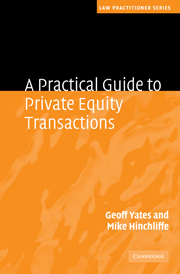Book contents
- Frontmatter
- Contents
- List of figures
- Foreword
- Preface and acknowledgments
- Table of cases
- 1 An introduction to private equity
- 2 The deal process and preliminary matters
- 3 Transaction structures and deal documents
- 4 Acquisition issues
- 5 Equity documentation
- 6 Debt funding
- 7 Employment-related issues
- 8 Pensions
- 9 Tax on private equity transactions
- 10 Public-to-private transactions
- 11 Living with the investment
- 12 Secondary buyouts
- 13 Exits
- Index
12 - Secondary buyouts
Published online by Cambridge University Press: 04 May 2010
- Frontmatter
- Contents
- List of figures
- Foreword
- Preface and acknowledgments
- Table of cases
- 1 An introduction to private equity
- 2 The deal process and preliminary matters
- 3 Transaction structures and deal documents
- 4 Acquisition issues
- 5 Equity documentation
- 6 Debt funding
- 7 Employment-related issues
- 8 Pensions
- 9 Tax on private equity transactions
- 10 Public-to-private transactions
- 11 Living with the investment
- 12 Secondary buyouts
- 13 Exits
- Index
Summary
Introduction
In a secondary buyout (often referred to simply as a ‘secondary’), a company which has already been subject to an existing management buyout is sold by its existing private equity backers and management to a new company backed by a separate private equity investor and some or all of the same managers. The typical feature, therefore, is that there is a change of private equity investor (and, sometimes, some of the managers), with many or all of the existing shareholding managers who obtained equity in the first buyout carrying over some of their investment into the new buyer vehicle. Whilst the investors and any managers who are not to continue with the business will sell their shares for cash, the other managers (often referred to as the ‘rolling managers’) will choose, or may perhaps be required, to sell their existing shares in exchange, in part at least, for shares in the new Newco. Of course, there can be many variants on this typical model, but the key feature is a change of private equity investor and a broad continuity of managers.
There is no reason why this second buyout company cannot itself later be sold to another company backed by a third set of investors with some or all of the same managers (a ‘tertiary’) and so forth. In this chapter, however, we will refer to all such transactions as a secondary, as the differences between a secondary and a tertiary is more one of history in terms of the investment than of form and substance in terms of the principal transactional issues.
- Type
- Chapter
- Information
- A Practical Guide to Private Equity Transactions , pp. 347 - 360Publisher: Cambridge University PressPrint publication year: 2010



